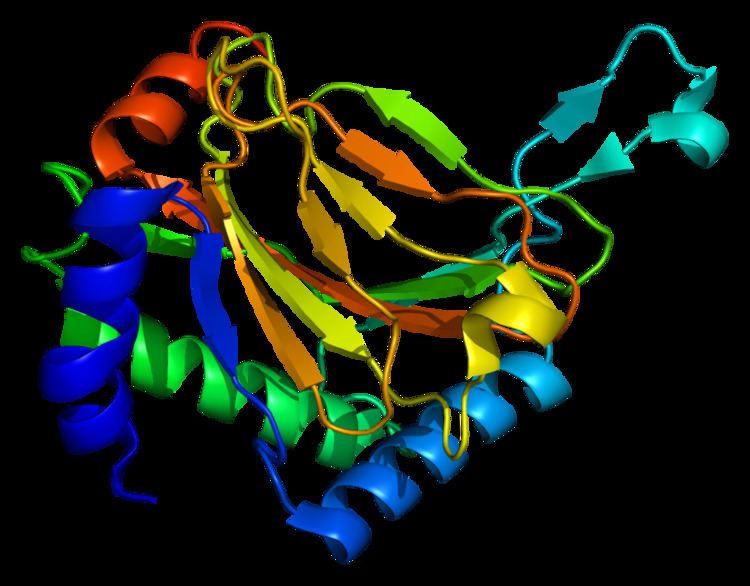Entrez 54583 | Ensembl ENSG00000135766 | |
 | ||
Aliases EGLN1, C1orf12, ECYT3, HIF-PH2, HIFPH2, HPH-2, HPH2, PHD2, SM20, ZMYND6, HALAH, egl-9 family hypoxia inducible factor 1 External IDs MGI: 1932286 HomoloGene: 56936 GeneCards: EGLN1 | ||
Hypoxia-inducible factor prolyl hydroxylase 2 (HIF-PH2), or prolyl hydroxylase domain-containing protein 2 (PHD2), is an enzyme encoded by the EGLN1 gene. It is also known as Egl nine homolog 1.
Contents
The hypoxia response
HIF-1α is a ubiquitous, constitutively synthesized transcription factor responsible for upregulating the expression of genes involved in the cellular response to hypoxia. These gene products may include proteins such as glycolytic enzymes and angiogenic growth factors. In normoxia, HIF alpha subunits are marked for the ubiquitin-proteasome degradation pathway through hydroxylation of proline-564 and proline-402 by PHD2. Prolyl hydroxylation is critical for promoting pVHL binding to HIF, which targets HIF for polyubiquitylation.
Structure
PHD2 is a 46-kDa enzyme that consists of an N-terminal domain homologous to MYND zinc finger domains, and a C-terminal domain homologous to the 2-oxoglutarate dioxygenases. The catalytic domain consists of a double-stranded β-helix core that is stabilized by three α-helices packed along the major β-sheet. The active site, which is contained in the pocket between the β-sheets, chelates iron(II) through histidine and aspartate coordination. 2-oxoglutarate displaces a water molecule to bind iron as well. The active site is lined by hydrophobic residues, possibly because such residues are less susceptible to potential oxidative damage by reactive species leaking from the iron center.
The enzyme has a high affinity for iron(II) and 2-oxoglutarate, and forms a long-lived complex with these factors. It has been proposed that cosubstrate and iron concentrations poise the HIF hydroxylases to respond to an appropriate "hypoxic window" for a particular cell type or tissue. Studies have revealed that PHD2 has a KM for dioxygen slightly above its atmospheric concentration, and PHD2 is thought to be the most important sensor of the cell's oxygen status.
Mechanism
The enzyme incorporates one oxygen atom from dioxygen into the hydroxylated product, and one oxygen atom into the succinate coproduct. Its interactions with HIF-1α rely on a mobile loop region that helps to enclose the hydroxylation site and helps to stabilize binding of both iron and 2-oxyglutarate.
Biological role and disease relevance
PHD2 is the primary regulator of HIF-1α steady state levels in the cell. A PHD2 knockdown showed increased levels of HIF-1α under normoxia, and an increase in HIF-1α nuclear accumulation and HIF-dependent transcription. HIF-1α steady state accumulation was dependent on the amount of PHD silencing effected by siRNA in HeLa cells and a variety of other human cell lines.
However, although it would seem that PHD2 downregulates HIF-1α and thus also tumorigenesis, there have been suggestions of paradoxical roles of PHD2 in tumor proliferation. For example, one animal study showed tumor reduction in PHD2-deficient mice through activation of antiproliferative TGF-β signaling. Other in vivo models showed tumor-suppressing activity for PHD2 in pancreatic cancer as well as liver cancer. A study of 121 human patients revealed PHD2 as a strong prognostic marker in gastric cancer, with PHD2-negative patients having shortened survival compared to PHD2-positive patients.
As an additional point of interest, recent genome-wide association studies have suggested that EGLN1 may be involved in the low hematocrit phenotype exhibited by the Tibetan population and hence that EGLN1 may play a role in the heritable adaptation of this population to live at high altitude.
As a therapeutic target
HIF's important role as a homeostatic mediator implicates PHD2 as a therapeutic target for a range of disorders regarding angiogenesis, erythropoeisis, and cellular proliferation. There has been interest both in potentiating and inhibiting the activity of PHD2. For example, methylselenocysteine (MSC) inhibition of HIF-1α led to tumor growth inhibition in renal cell carcinoma in a PHD-dependent manner. It is thought that this phenomenon relies on PHD-stabilization, but mechanistic details of this process have not yet been investigated. On the other hand, screens of small-molecule chelators have revealed hydroxypyrones and hydroxypyridones as potential inhibitors for PHD2. Substrate analog peptides have also been developed to exhibit inhibitory selectivity for PHD2 over factor inhibiting HIF (FIH), for which some other PHD-inhibitors show overlapping specificity.
